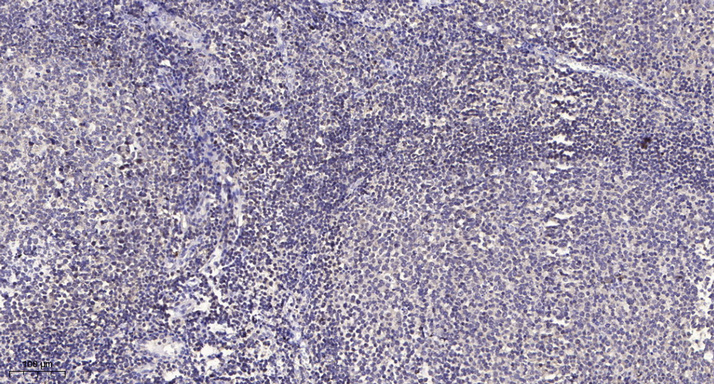ACAD-9 Polyclonal Antibody
- Catalog No.:YT0070
- Applications:IHC;IF;ELISA
- Reactivity:Human;Mouse;Rat
- Target:
- ACAD-9
- Gene Name:
- ACAD9
- Protein Name:
- Acyl-CoA dehydrogenase family member 9 mitochondrial
- Human Gene Id:
- 28976
- Human Swiss Prot No:
- Q9H845
- Mouse Gene Id:
- 229211
- Mouse Swiss Prot No:
- Q8JZN5
- Immunogen:
- Synthesized peptide derived from ACAD-9 . at AA range: 530-610
- Specificity:
- ACAD-9 Polyclonal Antibody detects endogenous levels of ACAD-9 protein.
- Formulation:
- Liquid in PBS containing 50% glycerol, 0.5% BSA and 0.02% sodium azide.
- Source:
- Polyclonal, Rabbit,IgG
- Dilution:
- IHC 1:100 - 1:300. ELISA: 1:20000.. IF 1:50-200
- Purification:
- The antibody was affinity-purified from rabbit antiserum by affinity-chromatography using epitope-specific immunogen.
- Concentration:
- 1 mg/ml
- Storage Stability:
- -15°C to -25°C/1 year(Do not lower than -25°C)
- Other Name:
- ACAD9;Acyl-CoA dehydrogenase family member 9; mitochondrial;ACAD-9
- Molecular Weight(Da):
- 69kD
- Background:
- This gene encodes a member of the acyl-CoA dehydrogenase family. Members of this family of proteins localize to the mitochondria and catalyze the rate-limiting step in the beta-oxidation of fatty acyl-CoA. The encoded protein is specifically active toward palmitoyl-CoA and long-chain unsaturated substrates. Mutations in this gene cause acyl-CoA dehydrogenase family member type 9 deficiency. Alternate splicing results in multiple transcript variants.[provided by RefSeq, Mar 2010],
- Function:
- cofactor:FAD.,disease:Defects in ACAD9 are a cause of acyl-CoA dehydrogenase family member type 9 deficiency (ACAD9 deficiency) [MIM:611126]. ACAD9 deficiency patients present with episodic liver dysfunction during otherwise mild illnesses or cardiomyopathy, along with chronic neurologic dysfunction.,function:Has a dehydrogenase activity on palmitoyl-CoA (C16:0) and stearoyl-CoA (C18:0). It is three times more active on palmitoyl-CoA then on stearoyl-CoA. Has little activity on octanoyl-CoA (C8:0), butyryl-CoA (C4:0) or isovaleryl-CoA (5:0).,similarity:Belongs to the acyl-CoA dehydrogenase family.,tissue specificity:Ubiquitously expressed in most normal human tissues and cancer cell lines with high level of expression in heart, skeletal muscles, brain, kidney and liver.,
- Subcellular Location:
- Mitochondrion inner membrane ; Peripheral membrane protein ; Matrix side . Essentially associated with membranes. .
- Expression:
- Ubiquitously expressed in most normal human tissues and cancer cell lines with high level of expression in heart, skeletal muscles, brain, kidney and liver (PubMed:12359260). In the cerebellum uniquely expressed in the granular layer (at protein level) (PubMed:21237683).
- June 19-2018
- WESTERN IMMUNOBLOTTING PROTOCOL
- June 19-2018
- IMMUNOHISTOCHEMISTRY-PARAFFIN PROTOCOL
- June 19-2018
- IMMUNOFLUORESCENCE PROTOCOL
- September 08-2020
- FLOW-CYTOMEYRT-PROTOCOL
- May 20-2022
- Cell-Based ELISA│解您多样本WB检测之困扰
- July 13-2018
- CELL-BASED-ELISA-PROTOCOL-FOR-ACETYL-PROTEIN
- July 13-2018
- CELL-BASED-ELISA-PROTOCOL-FOR-PHOSPHO-PROTEIN
- July 13-2018
- Antibody-FAQs
- Products Images

- Immunohistochemical analysis of paraffin-embedded human tonsil. 1, Antibody was diluted at 1:200(4° overnight). 2, Tris-EDTA,pH9.0 was used for antigen retrieval. 3,Secondary antibody was diluted at 1:200(room temperature, 30min).



